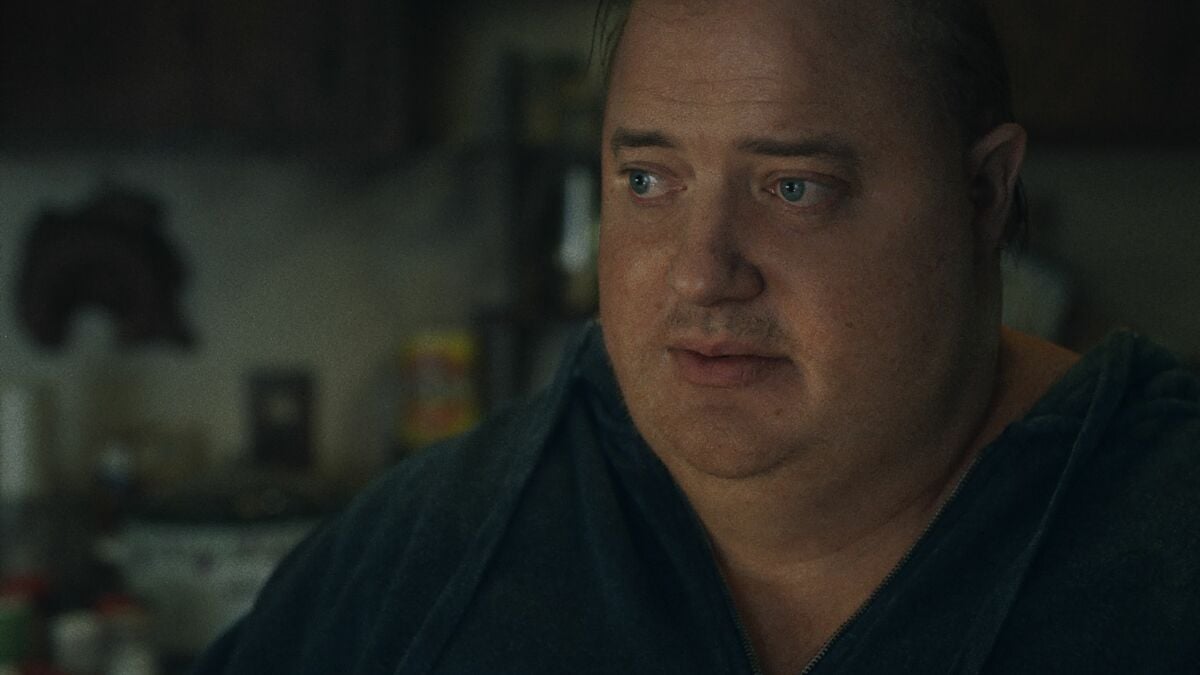Entertainment
How fat people were portrayed on screen in 2022

This year fat representation in film has been a heated debate: Miss Trunchbull’s formidable figure returned to our screens as Emma Thompson in a fat suit, Darren Aronofsky’s adaptation of the Samuel D. Hunter play The Whale, featured Brendan Fraser in, you guessed it, a fat suit. But this is a serious fat suit. This isn’t a Norbit fat suit. It isn’t an Austin Powers fat suit. It is a fat suit worn by an already bigger bodied Brendan Fraser, because according to Aronofsky, emotionally capable actors over three hundred pounds don’t exist.
While The Whale is easily the main discussion point for exploring 2022’s fat representation in film, the movie world also highlighted fat narratives (or lack thereof) in 3000 Years of Longing and The Banshees of Inisherin and this issue can be explored in films without fat narratives at all, like Glass Onion and Everything, Everywhere, All At Once.
Looking back over these five massive cinematic hits from the past 12 months, what can we glean about the way fat people are portrayed in film? Are we finally seeing signs of change or is there still more work to be done to end the dehumanising representations of fat people on our screens?
The misery porn of ‘The Whale’
Multiple fat positive outlets and activists have spoken out advising people not to go see The Whale. The film has been described as a “body horror” and “misery porn“, choosing to show the life of a fat person as a result of deep trauma as well as a slow death. The combination of up-close shots of Fraser’s fat suit moving around a small apartment, the people in his life’s beratement of his physique and a lack of empathy towards Fraser’s character culminate in making this not only one of the most fatphobic films of the year, but probably of all time.
The story follows Charlie, an English teacher who works from home, lecturing via a video call where he never turns the camera on, who is suffering from binge eating disorder following the death of his male lover. Depressed, Charlie has turned to food to sate his feelings and The Whale follows the last week of Charlie’s life after having suffered a heart attack due to his weight gain.
This film isn’t trying to empathise with the horrors of having an eating disorder, but instead looks to shock its audience with fatness
Multiple characters throughout the story berate Charlie for “letting himself” get to this point and, essentially, killing himself with his eating disorder (read: his fatness). His teenage daughter, played by Sadie Sink, who never forgave Charlie for leaving her mother for a man, hurls fatphobic and homophobic abuse at her father in the movie and instead of responding — either with an understandable sadness or anger — Charlie accepts the attacks. This in itself implies heavily that Charlie believes his fate — death — and these comments to be fair; the painful part is that many in the audience would agree.
The morality of being fat — and ergo, unhealthy — is a never ending issue for fat people online and off, and when films like Aronofsky’s paint fatness as a symptom of depression and helplessness, being fat becomes associated with not only being morally wrong but spiritually wrong also. In doing this, The Whale perpetuates the notion that all fat people are automatically deeply unhappy and in some ways, deserve to be so, solely because of their fatness.
Barely leaving the tiny apartment that Charlie lives in, the camera angles emphasise the size of Charlie in a way that makes his mass a spectacle: By panning in on rolls of flesh, showing graphic scenes of Charlie masturbating as well as gratuitous, visceral shots of him eating. The movie is even shot in a 4:3 aspect ratio to further highlight how big Fraser’s fat suit is, dehumanising the character from being sympathised with and instead alienating the audience from relating with Charlie. This film isn’t trying to empathise with the horrors of having an eating disorder, but instead looks to shock its audience with fatness while upholding harmful stereotypes of what fatness represents.
‘3000 Years of Longing’ and its spectacle of fatness
On the other end of the scale, 3000 Years of Longing makes a similar spectacle of fatness as a weakness. In a small portion of the film, during one of the many offshoot stories within the plot itself, we focus on two brothers. One of them, Murad lV (Ogulcan Arman Uslu), is a focused but frightening dictator who is prone to murderous rages. His younger sibling Ibrahim (Hugo Vella), however, is shown to be “debauched” and this is exemplified by his fat fetish. Also fat himself, Ibrahim is rarely seen without a shroud of large, naked ladies surrounding him. The narrator of the tale, played by Idris Elba, explains that in Ibrahim’s pursuit of pleasure, the more flesh, the better.
The younger brother’s stories are littered with physical comedy and puns surrounding his sexual predilections and his lax attitude towards ruling. Spoilers ahead, but once Ibrahim’s brother dies, Ibrahim has to be “dragged to the throne” according to the movie’s narrator and his weakness is further centred in the narrative.
When fat people’s bodies aren’t being used for physical comedy in cinema, they are used for shock factor.
He brings his harem along with him as he ascends to power and even in a royal setting, these women are mocked by the narrator and the storytelling. They are dehumanised by their presence solely being a representation of the king’s fat fetish, the only time one of them speaks is to be angry with the film’s narrator, the Djinn played by Idris Elba, and she is depicted as an angry, stupid fat woman. A stark contrast to the thin women in the film, who are often described as painstakingly beautiful and wise by the Djinn.
This character, Ibrahim’s “favourite”, is named (shockingly) “Sugar Lump”, and is also shown as clumsy, which is a fatphobic stereotype. Sugar Lump (Anna Adams) has a slip and a fall — while naked — large enough to crack the floor’s flagstone tile in half. The shot is shown in a mortifying slow motion, with the express intent of having the audience laugh at what would be a painful tumble for Sugar Lump.
When fat people’s bodies aren’t being used for physical comedy in cinema, they are used for shock factor. Seeing so many naked, fat women on screen hasn’t happened to me since the opening sequence of Tom Ford’s Nocturnal Animals (2016) and the intent feels exactly the same. Similar to 3000 Years of Longing, these women aren’t named, they do not speak, and they are given no personality. In the same way that the plus size characters in the intro to Nocturnal Animals perform completely nude and are used for spectacle’s sake, so too are the fat women of 3000 Years of Longing used for shock factor and removed of their agency, sexual or otherwise.
On top of this, the connection between decadence and fatness is a disturbing one and attributing debauchery to Ibrahim’s lust for larger women implies that there needs to be something wrong with the person who desires fat people — again, an implied moral failing — for fat people to be seen as sexual or desirable. Simultaneously, seeing these women as only being used/useful for sexual means adds to an undercurrent of oversexualisation that often happens to fat women. Fat women are either reprehensible or we are eroticised, and in the case of 3000 Years of Longing, both are utilised to demean us.
A glimmer of hope from ‘The Banshees of Inisherin’
The year hasn’t all been one-note fat characters though. The Banshees of Inisherin delivered us a complex and intriguing lead with Brendan Gleeson as Colm Doherty, a musician on an island just off the coast of Ireland who decides one day to stop speaking to his greatest friend Pádraic (Colin Farrell). This period drama barely mentions Doherty’s weight — except for a few fat jokes, spoken out of anger that are typical for the characters voicing them — and instead focuses on telling a sad and smart story about two friends, one of whom just happens to be fat. The story would be exactly the same if neither were fat, if both of them were fat, or if Farrell’s character Pádraic had been the fat one.

Credit: Jonathan Hession / Searchlight Pictures
As much as the screen sorely needs relatable and cohesive stories about the fat experience, it just as desperately needs fat characters in roles that have absolutely nothing to do with fatness, as exemplified by The Banshees of Inisherin and, in a smaller way, Everything, Everywhere, All At Once.
Jamie Lee Curtis makes a stand in ‘Everything, Everywhere, All At Once’
You may note that none of the actors in Everything, Everywhere, All At Once are fat. You may also be under the same misunderstanding I was before writing this article, that Jamie Lee Curtis donned a fat suit for her role as IRS manager Deidre. Actually, the opposite is true: Curtis specifically requested to be allowed to “let go” and not “conceal” how her body really looks. This is a direct contrast to her physique in Halloween Ends, which was also released this year and Curtis’ frame is notably slender and athletic.
In an Instagram post about Everything, Everywhere, All At Once and her body in it, Curtis elaborated: “In the world, there is an industry — a billion-dollar, trillion-dollar industry — about hiding the physical attributes of our bodies. Concealers. Shapewear. Fillers. Procedures. Clothing. Hair accessories. Hair products. Everything to conceal the reality of who we are. And my instruction to everybody was: I want there to be no concealing of anything.”

Credit: A24
Curtis continued, “I’ve been sucking my stomach in since I was 11, when you start being conscious of boys and bodies, and the jeans are super tight. I very specifically decided to relinquish and release every muscle I had that I used to clench to hide the reality. That was my goal. I have never felt more free creatively and physically.”
While Curtis is far from fat in this character and in her natural form, it is notable that when a celebrity is in such proximity to fatness and seen on screen as such, viewers assume she is wearing a fat suit. Director Daniel Kwan even noted this, saying, “Everyone assumes that her belly in the movie is a prosthetic, but it’s actually her real belly.”
But both these instances — Jamie Lee Curtis rejecting spanx and Brendan Gleeson getting cast in a movie — make barely any progress in a world that is giving fatphobic films like The Whale six minute standing ovations.
Glass Onion completely failed us
The films above barely make a dint in the films released this year, and every year, with no fat representation at all. While I adored seeing Glass Onion recently, it struck me halfway through that nobody in the main cast was anything other than thin, and if they were larger, it was due to piles of muscles and not rolls of fat. Any of these characters, much like in The Banshees of Inisherin, could have been played by a fat actor — we could have had a fat millionaire, a fat influencer, a fat school teacher, a fat politician, and the story would have remained the same. It isn’t hard to imagine this cinematic universe hosting a cast made up of Queen Latifah, Jack Black, Jennifer Coolidge, Jonah Hill or Craig Robinson, so why weren’t any of the legion of bigger bodied comedic actors cast?
The issue with fatness in cinema in 2022 is twofold: We are either never shown on screen or when we are, it is laced with such potent hatred and mockery of our bodies that it makes invisibility feel like the better option.
But where do we go from here? The answer doesn’t just lie in the casting rooms, but requires the employment of fat directors and fat writers, adapting from fat positive texts or writing entirely new fat positive scripts with a focus on ensuring that when our stories are told, they are so much more than a fetishist’s dream or a voyeuristic, perverse tragedy. As well as casting fat actors in roles that do not require a character to be thin, fat audiences and fat actors deserve fleshed out parts that analyse and amplify our stories with an egalitarian point of view.
-

 Business7 days ago
Business7 days agoMood.camera is an iOS app that feels like using a retro analog camera
-

 Business6 days ago
Business6 days agoUnitedHealth says Change hackers stole health data on ‘substantial proportion of people in America’
-

 Business5 days ago
Business5 days agoTesla’s new growth plan is centered around mysterious cheaper models
-

 Business4 days ago
Business4 days agoXaira, an AI drug discovery startup, launches with a massive $1B, says it’s ‘ready’ to start developing drugs
-

 Business5 days ago
Business5 days agoUK probes Amazon and Microsoft over AI partnerships with Mistral, Anthropic, and Inflection
-

 Entertainment3 days ago
Entertainment3 days agoSummer Movie Preview: From ‘Alien’ and ‘Furiosa’ to ‘Deadpool and Wolverine’
-

 Business6 days ago
Business6 days agoTwo widow founders launch DayNew, a social platform for people dealing with grief and trauma
-

 Entertainment6 days ago
Entertainment6 days agoTesla’s in trouble. Is Elon Musk the problem?




























